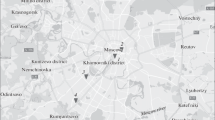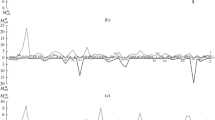Abstract
Six years of observations (1980 to 1986) of the composition of lower tropospheric aerosols at Alert on northern Ellesmere Island in the Canadian high Arctic yield insight into the seasonal variation of Arctic air pollutants as well as of substances of natural origin. A principal component analysis of 138 observations of 21 aerosol constituents (major ions, metals, nonmetallic trace elements) for the most polluted period of December to April identified not only a soil, sea salt and anthropogenic aerosol component, but also one associated with photochemical reactions in the atmosphere that occur at polar sunrise. Depending on the source of their gaseous precursors, elements in the photochemical component can be natural or anthropogenic in origin. For instance, SO4 2-, existing mostly as H2SO4, originates probably from both anthropogenic and natural sources while Br− is likely of marine origin. In contrast, SO4 2- in the anthropogenic component has the stoichiometry of NH4HSO4. In the winter months, over 90% of Arctic SO4 2- is in the anthropogenic and photochemical components.
In winter, a substantial portion (11 to 35%) of Na+ is associated with the anthropogenic aerosol component suggesting either that marine aerosols have been physically or chemically modified by interactions with air pollution or that there are anthropogenic sources of Na+.
The aerosol soil component is controlled by both local and distant dust sources. During a year, it has two peaks at Alert, one in April/May coinciding with the Asian dust storm season and one in September.
There is a marked difference in the seasonal variation of particulate Br− and iodine concentrations in the air. Both have a peak in April/May associated with polar sunrise and, hence, photochemical reactions in the atmosphere. However, iodine also peaks in early fall. This may be a product of biogenic iodine emissions to the atmosphere during secondary blooms in northern oceans in late summer.
Similar content being viewed by others
References
Barrie, L. A., Hoff, R. M., and Daggupaty, S. M., 1981, The influence of mid-latitudinal pollution sources on haze in the Canadian Arctic, Atmos. Environ. 15, 1407–1419.
Barrie, L. A. and Hoff, R. M., 1984, The oxidation rate and residence time of sulphur dioxide in the Arctic atmosphere, Atmos. Environ. 18, 2711–2722.
Barrie, L. A. and Hoff, R. M., 1985, Five years of air chemistry observations in the Canadian Arctic, Atmos. Environ. 19, 1995–2010.
Barrie, L. A., 1986, Arctic air pollution: an overview of current knowledge, Atmos. Environ. 20, 643–663.
Barrie, L. A., Bottenheim, J. W., Schnell, R. C., Crutzen, P. J., and Rasmussen, R. J., 1988, Ozone destruction and photochemical reactions at polar sunrise in the lower Arctic troposphere, Nature 334, 138–141.
Barrie, L. A., Den, Hartog, G., Bottenheim, J. W., and Landsberger, S., 1989a, Anthropogenic aerosols and gases in the lower troposphere at Alert Canada in April 1986, J. Atmos. Chem. 9, 101–127.
Barrie, L. A., Olson, M. P., and Oikawa, K. K., 1989b, The flux of anthropogenic sulphur into the Arctic from mid-latitudes in 1979/80, Atmos. Environ. 23, 2505–2512.
Berg, W. W., Sperry, P. D., Rahn, K. A., and Gladney, E. S., 1983, Atmospheric bromine in the Arctic, J. Geophys. Res. 88, 6719–6736.
Bottenheim, J. W., Gallant, A. J., and Brice, K. A., 1986, Measurements of NO y species and O3 at 82° N latitude, Geophys. Res. Lett. 13, 113–116.
Bottenheim, J. W., Barrie, L. A., Atlas, E., Heidt, L. E., Niki, H., Rasmussen, R. A., and Shepson, P. B., 1990, Depletion of lower tropospheric ozone during Arctic spring: the polar sunrise experiment 1988, J. Geophys. Res., in press.
Erickson, D. J., Merrill, J. T., and Duce, R., 1986, Seasonal estimates of global atmospheric sea salt distributions, J. Geophys. Res. 91D, 1067–1072.
Koerner, R. M. and Fisher, D., 1982, Acidic snow in the Canadian high Arctic, Nature 295, 137–140.
Li, S.-M. and Winchester, J. W., 1990, Megahaze and other aerosol components in late winter Arctic Alaska, 1986, J. Geophys. Res. 95, 1797–1810.
Li, S.-M. and Winchester, J. W., 1989a, Resolution of ionic components of late winter Arctic aerosols, Atmos. Environ. 23, 2387–2400.
Li, S.-M. and Winchester, J. W., 1989b, Geochemistry of organic and inorganic ions of the late winter Arctic aerosol, Atmos. Environ. 23, 2401–2416.
Lowenthal, D. H. and Rahn, K. A.,1985, Regional sources of pollution aerosol at Barrow, Alaska during winter 1979–1980 as deduced from elemental tracers, Atmos. Environ. 19, 1995–2010.
Pacyna, J. M. and Ottar, B., 1989, Origin of natural constituents in the Arctic aerosols, Atmos. Environ. 23, 809–815.
Prospero, J. M., 1990, Mineral-aerosol transport to the north Atlantic and the north Pacific: the impact of African and Asian sources, in A. H., Knap (ed.), The Long Range Atmospheric Transport of Natural and Contaminant Substances, Kluwer Academic Pubs., Dordrecht, pp. 59–82.
Raatz, W. E. and Shaw, G. E., 1984, Long range transport of pollution aerosols into the Alaskan Arctic, J. Clim. Appl. Meteorol. 23, 1052–1064.
Rahn, K. A., Borys, R. D., and Shaw, G. E., 1977, The Asian source of Arctic haze bands, Nature 268, 713–715.
Savoie, D. L. and Prospero, J. M., 1989, Comparison of oceanic and continental sources of non-sea-salt sulphate over the Pacific Ocean, Nature 339, 29, 685.
Schutz, L. and Rahn, K. A., 1982, Trace element concentrations in erodible soils, Atmos. Environ. 16, 171–176.
Sturges, W. T. and Barrie, L. A., 1988, Chlorine, bromine and iodine in Arctic aerosols, Atmos. Environ. 22, 1179–1194.
Thurston, G. D. and Spengler, J. D., 1985, A quantitative assessment of source contributions to inhalable particulate matter pollution in metropolitan Boston, Atmos. Environ. 19, 9–25.
Uematsu, M., Duce, R. A. and Prospero, J. M., 1985, Deposition of atmospheric mineral particles in the north Pacific Ocean, J. Atmos. Chem. 3, 123–128.
Author information
Authors and Affiliations
Rights and permissions
About this article
Cite this article
Barrie, L.A., Barrie, M.J. Chemical components of lower tropospheric aerosols in the high arctic: Six years of observations. J Atmos Chem 11, 211–226 (1990). https://doi.org/10.1007/BF00118349
Received:
Issue Date:
DOI: https://doi.org/10.1007/BF00118349




